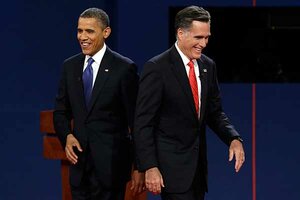Presidential debate 101: Does Romney have a $5 trillion tax cut, or not?
Obama insisted during the first presidential debate that Romney would cut taxes by $5 trillion over 10 years. Here's where that figure comes from – and why Romney rejects it.

President Obama walks past Republican presidential nominee Mitt Romney during the first presidential debate at the University of Denver, Wednesday, Oct. 3, in Denver.
Charlie Neibergall/AP
In terms of numerical assertions, Wednesday’s presidential debate at times seemed like a playground fight instead of a substantive encounter. President Obama and GOP nominee Mitt Romney threw figures at each other as if they were snowballs.
“You’ve got a $5 trillion tax cut!”
“Do not! You’re the one with a $716 billion Medicare cut!”
“Not true!”
"Yes true!”
And so on. Eventually the school bell rang and they had to go in. Or moderator Jim Lehrer said it was over and they shook hands. One or the other.
That can’t be edifying for viewers who don’t keep Congressional Budget Office reports on their bedside tables. So we’ll try to explain in a basic way the facts as we understand them behind some of the candidates' primary substantive disagreements.
We’ll start with the $5 trillion tax cut mystery. At the beginning of the debate, Mr. Obama charged that Mr. Romney’s economic plan calls for a tax reduction of that dollar figure, and that one of the “central questions of the campaign” is how the former Massachusetts governor will pull that off without shifting more of the US tax burden onto the middle class.
Romney said flatly “I don’t have a $5 trillion tax cut.” He said the US should provide tax relief to the middle class, without reducing the share of taxes paid by high-income people.
What’s the story here?
It is true that a central facet of Mitt Romney’s economic plan is a 20 percent across-the-board reduction in marginal tax rates, plus elimination of the estate tax and the alternative minimum tax (AMT). Do the math on how much money the federal government would forgo as a result of this, and it’s about $456 billion a year. Over 10 years, that rounds up to $5 trillion. That's the calculus behind the "$5 trillion tax cut" figure that Obama cites.
However, that’s only part of the tax plan. Romney has said he would make his overall tax changes revenue-neutral. He’d hack out deductions, exemptions, and other exclusions to broaden the tax base, for one thing. For another, he says that lowering marginal rates would increase economic activity, and hence tax revenue. These changes would counterbalance any revenue lost from rate reductions, according to Romney.
Those are ambitious goals, and Romney hasn’t provided more than hints about which deductions and exemptions he’d try to get rid of. Without such specifics to go on, the nonpartisan Tax Policy Center ran the numbers on Romney’s plan, and decided they just don’t add up. A revenue-neutral tax reform that includes 20 percent marginal cuts, no estate tax or AMT, gets rid of a substantial portion of deductions, and keeps existing tax breaks for investments (as Romney has said he would) ends up shifting about $86 billion in annual tax costs onto the middle class, it reported.
No surprise, the Romney camp has hotly contested the results of this study, saying it’s flawed. Romney has started to speculate on possible additional tax details, such as a cap on the deductions that wealthy taxpayers can claim. Faced with a tax plan that shifted the burden to the middle class, Romney could change course – reducing the size of the marginal reductions, say.
But as long as the Romney campaign doesn’t provide concrete tax specifics, the Obama camp will be happy to provide them for him, framing the plan in the worst possible light. For a voter, the most important question may not be whether this is fair. It might be this: Given the circumstances described, what do they think President Romney would actually do if he had to juggle things to make his numbers work?


